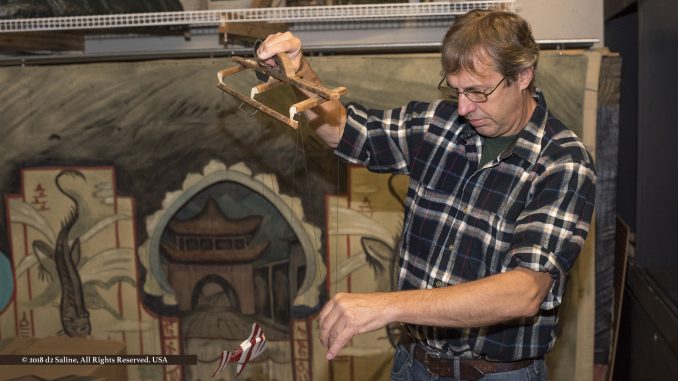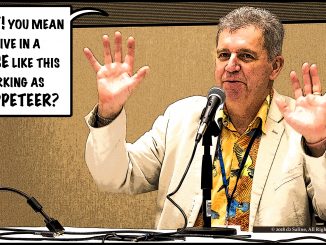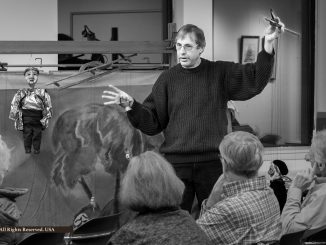
Last week, Saline Journal provided an expanded overview of marionette history and detailed its ongoing relevance to modern day entertainment in the United States. [1]
That article merely touched on the fantastic role once held by the City of Saline within it. To say that Meredith Bixby played a key role does little more than start the discussion. To think that having seen examples of his craft displayed at City Hall or showcased in the local library is to confuse teaser with feature. [2]
“Erik Grossman is one of the few people remaining who can tell the whole story,” Mayor Brian Marl said.
Mr Grossman knew “Meredith since I was two-years-old.” He went on to become a friend and pupil of the puppeteering master. Accordingly, the story properly begins with the pure seredipity by which Meredith Bixby had first become interested in marionettes — having happened upon A Repertory of Marionette Plays by Paul McPharlin, while away at Art Students League in New York City. Subsequently, in the mid-1930s, the young artist and his wife, acquired a new car coupled with specially-fitted trailer to literally take his show on the road. [3,4,5]
From there the story has been too often reduced to the simplistic stuff of too common cut-and-paste references. [6]
Meredith Bixby’s ‘Meredith Marionettes Touring Company’ toured the Midwest and south for more than 40 years, performing in schools, theaters, and community centers. His handcrafted puppets have appeared in 20,000 performances over the years.
The man and his accomplishments were far more complex, and fascinating.
Yes, there were the scripts from which the string-puppet shows were performed. Some were familiar, like The Wizard of Oz or Jack and the Beanstalk. Others, he wrote from whole cloth. But “storyteller” is too small a box for classifying Mr Bixby. As well as those related to conceiving entire productions from fertile imagination and tactical implementer for all of the above. [7,8]
For he also successfully marketed these performances. Those who remember having seen (or, better still, kept!) promotional flyers would no doubt agree that they are works of art in and of themselves. Mr Bixby wrote the copy that attracted new and returning audiences. He also drew all accompanying images.
Thanks to Erik Grossman, examples of original artwork have been preserved. “Meredith rolled them up after they were used to make the flyers,” Mr Grossman noted. “But he didn’t think they were worth anything. They’d served their purpose: To make the flyers. He was going to throw them away.”
Yet, adding “visual art” to the Bixby résumé only makes it slightly closer to complete. True, he put these skills to fine affect in painting his marionettes. He went beyond this to paint the numerous and varied backdrops required for shows. Not simply painting, however. With that work came an acquired knowledge of the mixtures required to survive multiple rollings and unrollings of the muslins without compromise to images the held. His clever trick was a combination of oil and kerosene that ensured pliability.
Another layer still was his thinking as a mechanical engineer. Grace Shackman made passing reference to this two decades ago in her nicely researched piece for the Community Observer, writing that he “started college at Wayne State University studying engineering.” [9]
Another bit of trivia to whet the appetite for particulars.
How might those aforementioned backdrops have been hung and countered in order to roll during performances such as Jack and the Beanstalk — moving to give the effect of puppet-Jack’s ascension? What of the challenges in working with the proportionate size of Jack’s foe? Further contrivances were added to behind-the-scenes structures so that the heavy puppet-Giant could be hung for puppeteer respites without distracting from performances that continued elsewhere on the stage.
Bringing facial features to life was touched upon here last time. But what of their bodies and range of movement? All of the necessities for figures now being discussed on online tutorials were well familiar to Meredith Bixby. In fact, Mr Grossman has argued that many of them originated with the Saline master puppeteer. Moreover, Mr Bixby was not just concerned about mechanics necessary for string puppets to do what they must do, or that he would wish them to do — but also designs that restricted against unnatural human movement. [10,11]
By this point it should be clear that the story of Meredith Bixby and his marionettes cannot be understood in either Cliffs Notes summery or any one single point of view. Incredibly, this was one man in whom could be uniquely found a majority of the key stories vital to a complete understanding of string puppets, history through practice. [12]
Wouldn’t it be incredible if that life’s work had been largely preserved? If those archived materials could then be brought together, strategically organized to create an unparalled attraction for casual interests, serious scholarship, and even a backdrop for future performances?
Part 2 of this article picks up with that very question, tomorrow on the Saline Journal.
References
- “Once Upon A Time, Marionettes Set The Stage For Entertainment Techniques That Remain Relevant To This Very Day” Dell Deaton (September 10, 2018) Saline Journal.
- Saline District Library (home page).
- “Paul McPharlin” World Encyclopedia of Puppetry Arts.
- Art Students League of New York (home page).
- “Saline’s Mrs Bixby Dies; Marionettes Lose Voice” (November 3, 1972) Ann Arbor News.
- “Bixby Marionettes Trust” Saline.
- The Wonderful Wizard of Oz (Library of Congress) L Frank Baum (1899).
- Jack and the Beanstalk and Other Stories (Library of Congress) Benjamin Tabart (1734).
- “The puppeteers looked like giants” Grace Shackman (Summer 1998) Community Observer.
- “Frisch Marionette Tutorial: Making Puppet Heads with MendALL Wood Filler” The Frisch Marionettes Puppet Shows (September 8, 2014) YouTube.
- “Mastering Marionettes: Marionette Anatomy & Movement – FREE CHAPTER” Stan Winston School (September 16, 2016) YouTube.
- Cliffs Notes (home page).



